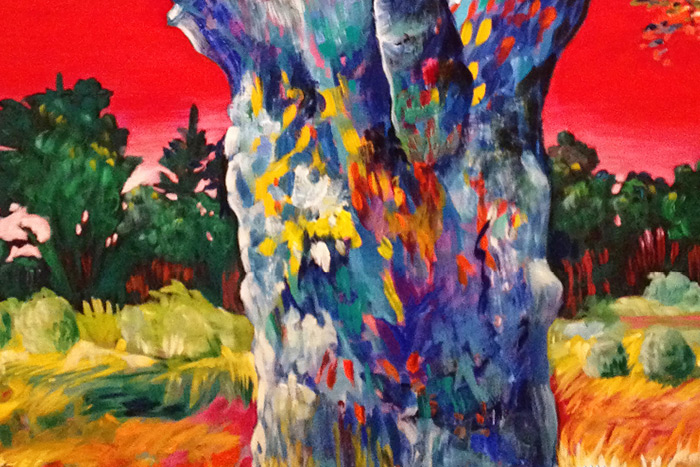Basquiat to b.j. spoke: Meet Dan's Papers Cover Artist Cindy Shechter

Cindy Shechter started teaching art in a Brooklyn elementary school in the late ’60s where she taught the future graffiti artist Jean Michel Basquiat. “I like to think that I had some influence on his success as an artist,” she said when we talked to her about her work.

What inspired “A Tree in the Field?”
I saw a tree up in the Catskill Mountains and I photographed it. Although the photograph was in color the tree seemed to have more life and character in it than the photo revealed. I used the photograph as a guide for my painting. I feel that art should be more than just a copy of reality, and that the function of the artist is to interpret reality through his own eyes. Because of that I added lots of color and texture to bring out what I saw as the tree’s real character.
What draws you to trees as a subject?
My husband and I started spending time at our vacation home in the mountains and suddenly trees were all around me. I began to take a closer look. The trunks were a neutral gray-brown color, but the texture of the bark and the branches, the patterns, the lines and the rhythms they each presented were all unique. They each spoke to me in a different way. I brought them to life with prismatic color and emphasized their individual textures and patterns. My goal is to try to capture the expressive quality of an individual tree as well as its natural beauty.
You usually express yourself via Abstract Expressionism, something casual art observers often disregard. What do they need to know in order to better appreciate the art form?
Abstract Expressionism appealed to me since the paint itself became the focus. It emphasizes shape, color, line, form and texture. It free the artist and allows him to be expressive and show emotions, spontaneity, and individual feelings. It is often hard for the casual viewer to understand Abstract Expressionism. They are looking for subject matter and often ask, “What is it?” I would tell the observer to suspend his dependence on reality and focus on how the painting makes him feel.
As a former fine art teacher can you discuss how important arts programing and education is in schools today?
Art is a universal language and a very important part of the curriculum. It’s a language for the non-verbal child; it provides a means of problem solving; it is an avenue for creative thinking and exploration; it expands one’s way of seeing; it is a way to explore the cultures of the world; and it can be a means to boost self-esteem. I have seen failing students awaken and “cutters” return to school because of art class.
What advice do you have for young aspiring artists?
Work all the time to improve your skills. Experiment with many different media and areas of art such as acrylic paint, oil paint, watercolors, sculpture, photography, printmaking, graphic arts, digital arts and don’t limit yourselves to what has been done in the past. Visit museums, try new things, explore, experiment all the time. At the same time, take art classes to learn time-tested techniques.
Can you talk about b.j. spoke gallery and the importance of artists working together toward a common purpose?
I have enjoyed becoming a member of a diverse group of artists who speak the same art language. Seeing other artists’ work, learning from them, being informally critiqued helps me grow as an artist and expand my vision. I think it helps all of our members promote the arts in the community.
Visit cindyshechter.com to see more of Shechter’s work, also on display at b.j. spoke gallery, 299 Main Street, Huntington, bjspokegallery.org.




